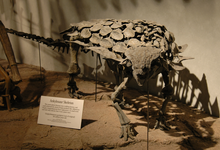Dracopelta
| Dracopelta Temporal range: Late Jurassic,
| |
|---|---|
| Scientific classification | |
| Domain: | Eukaryota |
| Kingdom: | Animalia |
| Phylum: | Chordata |
| Clade: | Dinosauria |
| Clade: | †Ornithischia |
| Clade: | †Thyreophora |
| Clade: | †Ankylosauria |
| Family: | †incertae sedis |
| Genus: | †Dracopelta |
| Species: | †D. zbyszewskii
|
| Binomial name | |
| †Dracopelta zbyszewskii Galton, 1980
| |
Dracopelta (meaning “dragon shield”) is a monospecific genus of ankylosaur dinosaur from Portugal that lived during the Late Jurassic (uppermost lower Tithonian-upper Tithonian, 152.1-145.0 Ma) in what is now the Lourinhã Formation. The type and only species is Dracopelta zbyszewskii, which is represented by a partial skeleton including unpublished material.[1][2]
Discovery and naming

In 1963 or, more likely, early 1964, a partial
The holotype was originally, and incorrectly, identified to be from the Kimmeridgian stage of Ribamar.[1][2][3] However, Antunes and Mateus (2003) noted that at a locality named Ribamar, there are outcrops of Lower Cretaceous that date to the Valanginian and Albian stages and deemed it as highly unlikely that the specimen was obtained from that locality.[4] Pereda-Suberbiola et al. (2005) determined that the specimen was from a locality constrained to the uppermost lower Tithonian-upper Tithonian which shows characteristics consistent with what is recognized in the Assenta Member of the Lourinhã Formation, an observation agreed upon by Russo and Mateus (2021).[3]
In 2019, a specimen of an ankylosaur consisting of a nearly complete skull, articulated dorsal vertebrae, proximal half of ribs, articulated anterior caudal vertebrae, mostly complete and articulated synsacrum, fragments of disarticulated and broken ribs, femora, partial ilia with attached pelvic shield, humerus, partial scapulocoracoid, tendons mostly attached to vertebrae, and osteoderms from the Lourinhã Formation was reported.[5] The specimen is currently being studied on to clarify if it represents an additional, more complete specimen, of Dracopelta or a new taxon.[1]
Description

Dracopelta has an estimated body length of 3 metres (9.9 feet) and a weight of 300 kilograms (600 lb).[6] The holotype specimen represents an adult individual.[3]
Galton (1980) originally diagnosed Dracopelta based on the small flat osteoderms, small medial paired circular plated with raised centre and rims, long anterolateral plates, narrow nonprojecting overlapping dorsolateral plates and overlapping laterally projecting lateral plates in the thoracic region.
Suberbiola et al. (2005) noted that the manus of Dracopelta may have retained a primitive phalangeal formula, as in the nodosaurid Sauropelta and basal thyreophoran Scutellosaurus, while ankylosaurids and stegosaurs showed a reduced phalangeal formula.[3] Suberbiola et al. suggested that derived ankylosaurids and stegosaurs convergently evolved a tridactyl pes, with the loss of digit I, while Liaoningosaurus pertained a tetradactyl manus and a tridactyl pes.[3] The authors interpreted that Dracopelta may have had cursorial adaptations as the autopodial structure falls into the metapodial range of the basal thyreophorans Scutellosaurus and Scelidosaurus, which were probably subcursorial.[3] The small size of Dracopelta is also consistent with the interpretation.[3]
Classification

Galton (1980) originally assigned Dracopelta to
Paleoenvironment

The holotype specimen of Dracopelta was obtained from a layer from the Assenta Member of the Lourinhã Formation, which dates to the uppermost lower and upper Tithonian stage of the Late Jurassic.
See also
References
- ^ .
- ^ .
- ^ .
- .
- ^ a b Russo, João (2019). A NEW ANKYLOSAUR DINOSAUR SKELETON FROM THE UPPER JURASSIC OF PORTUGAL (PDF). FCT-NOVA.
- ^ Paul, G.S., 2010, The Princeton Field Guide to Dinosaurs, Princeton University Press p. 231
- ^ Vickaryous, M. K., Maryanska, T., and Weishampel, D. B. (2004). Chapter Seventeen: Ankylosauria. in The Dinosauria (2nd edition), Weishampel, D. B., Dodson, P., and Osmólska, H., editors. University of California Press.
- ISBN 0-253-33964-2.
- S2CID 214625754.
- .
- ^ Mocho, Pedro; Ortega, Francisco; Royo-Torres, Rafael (2012). "Morphological variation of Turiasauria-like teeth and their stratigraphic distribution in Portuguese Upper Jurassic" (Document). Laboratório de Paleontologia e Paleoecologia.
- PMID 28273086.
